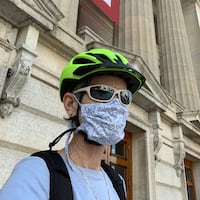The Ohio Department of Health on Monday reported 9,272 new cases and 63 deaths over the past 24 hours and 5,121 currently hospitalized patients. Ohio’s cumulative numbers are now: 484,297 cases, 29,569 hospitalizations and 7,022 deaths.
“This is very serious. It is definitely different than the first wave,” said C.J. Adams, a nurse manager at TriHealth Bethesda North Hospital. “We’re seeing more people. We’re seeing capacity issues. We’re seeing staffing challenges. It’s not just affecting COVID patients. If there are no beds in the hospital, it doesn’t matter if you have COVID or are having a heart attack, everyone is affected.”
Ohio Department of Health Chief Medical Officer Dr. Bruce Vanderhoff said as hospitals get busier, the priority will shift to focus care for the very sickest and preventing immediate deaths. “These are very, very serious next steps we’d be looking at,” he said.
The governor warned that Ohio will see a significant one-day spike in case numbers Tuesday when 12,600 cases are added to the tally. These were determined through positive antigen tests, which are quicker but less sensitive. The CDC changed its guidance on how to report antigen tests and Ohio will now follow those recommendations, resulting in the additional cases. Those cases will be cross-checked to eliminate duplication.
To be clear, all of these backlogged tests will not translate into new cases. They'll be checked/duplicate records will be removed. We'll also add these test results to our positivity calculation in the coming weeks. We will let you know when that change will be made.
— Governor Mike DeWine (@GovMikeDeWine) December 7, 2020
The state will report COVID-cases by antigen tests, PCR tests and both combined so the public can see each category.
DeWine said vaccine information will also be displayed on the state’s coronavirus website to show a running count of how many people have received shots.
By late December, Ohio expects to receive nearly 650,000 doses of vaccines manufactured by Pfizer and Moderna. The first doses will be given to hospital workers, people who are in contact with those who have COVID, nursing home residents and staff, and emergency medical responders.
“The next group is where I think it’s going to be more difficult. You’re going to have more difficult discussions. Who do you prioritize next? I think looking at who, because of their age, because of their occupation or because of other reasons, because of their medical condition, who are the most at risk. We’re going to have to look at that,” DeWine said.
DeWine reported that 45% of K-12 students statewide are doing remote learning and 25% are going to in-person classes part-time.
DeWine sidestepped a question about whether the Ohio Statehouse is safe for visitors, after Ohio House members reported being positive for the virus. The governor reiterated advice: Wear a mask.
State Rep. Rick Carfagna, R-Genoa Twp., and state Rep. John Patterson, D-Jefferson, disclosed they each tested positive. A second Republican also tested positive but hasn’t been publicly identified.
Carfagna and Patterson attended a 45 minute meeting last week of the House Finance Committee, a room that held at least two dozen lawmakers in somewhat close quarters. They also attended the Ohio House session for more than two hours on Wednesday, where dozens of lawmakers met, including more than a dozen who did not wear masks.
Where to get tested
Pop-up COVID-19 testing will take place from 10 a.m. – 3 p.m. Wednesday, Dec. 9, at Bethesda Temple, 3701 Salem Ave., Dayton. There’s no cost and no doctor’s order required. More testing options are listed online at coronavirus.ohio.gov.
About the Author

